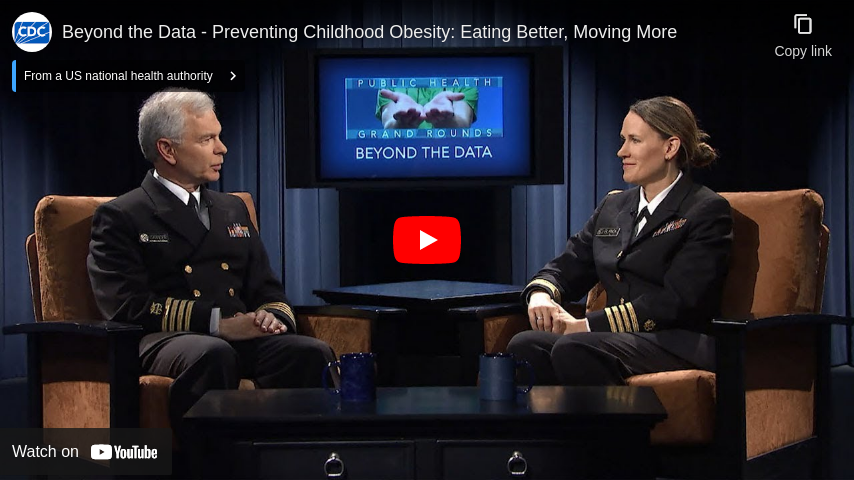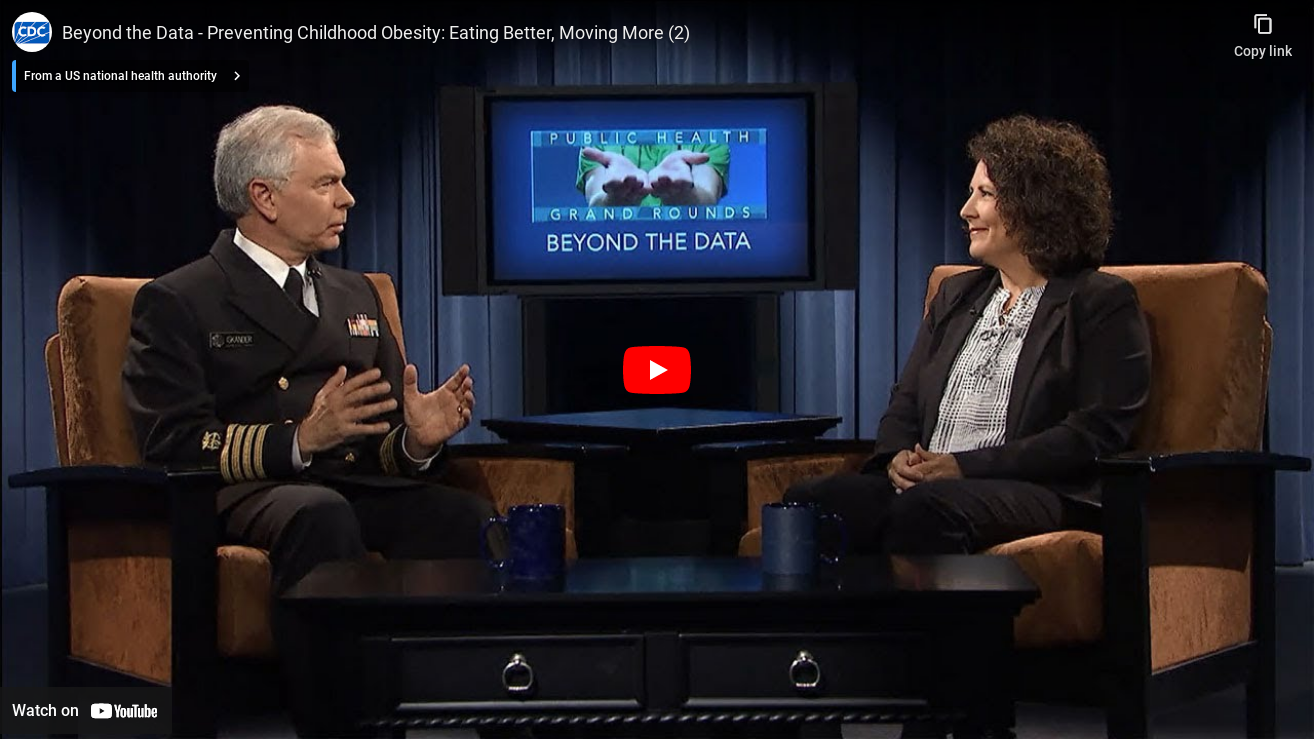Preventing Childhood Obesity – Eating Better, Moving More
Presented on .
The August session of Grand Rounds “Preventing Childhood Obesity – Eating Better, Moving More,” was viewed in 7 foreign countries and in 48 states, plus the District of Columbia.
Childhood obesity is a serious problem in the United States. Nearly 1 in 5 children and adolescents have obesity. Children with obesity are at risk for high blood pressure, high cholesterol, diabetes, and breathing problems. Additionally, children who have obesity are most likely to become adults with obesity. Most children spend time in care outside of their home, making Early Care and Education (ECE) settings and schools some of the best places to reach children with obesity prevention efforts.
This session of Public Health Grand Rounds will explore how ECE facilities and schools can directly impact what children eat and drink, how active they are, and how changes in these environments can help build a foundation of healthy habits for all children.
Dr. John Iskander and Captain Heidi Blanck discuss the important role Early Care and Education (ECE) settings and schools play in reaching children with obesity prevention efforts.
Dr. John Iskander and Mikki Duran discuss the innovative approaches the Appleton Area School District is taking to get school children active and fit. Find out how “active classrooms” and “Fit and 15” are among the approaches showing success.
Is there any data to suggest that increased opportunities for walking or biking to school has shown a reduction in prevalence of childhood obesity that can be shared.
In the presentation, I talked a lot about multicomponent interventions that address both diet and physical activity and include opportunities for parent and community engagement. Walk and bike to school campaigns have been featured as part of several successful comprehensive interventions and are a part of CDC’s approach to promoting physical education and physical activity in school. I’m less aware of an evidence base to support active transportation to school as a standalone obesity prevention strategy. We know that distance to school is a key factor determining whether kids have a walk or bike commute and that the percentage of youth that walk or bike to school drops off greatly among those living more than a half mile from school. Walking or biking a quarter mile or half mile to school contributes to daily physical activity, but it’s probably not intensive or extended enough of a burst to meaningfully move the needle on BMI. That said, I think a great opportunity for future research would be looking more at co-benefits of walking or biking to school—like school breakfast participation, classroom behavior, and children’s ability to focus.
Are there any particular state or city programs that have successfully promoted health in fitness/nutrition/primary care/mental health awareness, all things public health related, that can be easily duplicated, cost little with huge upside and get enthusiastic community support and involvement of local organizations (who also stand to benefit from a "healthier" community)?
Thank you for your question. Here are a few resources that may be of interest:
- Early this year, Preventing Chronic Disease published a special collection highlighting success stories from two CDC Cooperative Agreements that focused on preventing chronic disease. You can view the full collection here: https://www.cdc.gov/pcd/collections/pdf/PCD_StateAndLocal_Collection_FINAL_3-27-18.pdf
- You can find additional success stories in CDC’s National Center for Chronic Disease Prevention and Promotion success story database. You can filter by partner/awardee group. We recommend looking at stories from the State Public Health Actions program and Racial and Ethnic Approaches to Community Health (REACH). You can access the database here: https://nccd.cdc.gov/nccdsuccessstories/searchstories.aspx
- Lastly, we recommend looking at the National Collaborative on Childhood Obesity Research’s (NCCOR) SNAP-Ed Toolkit which provides several ECE, School and other evidenced based interventions. The toolkit is available here: https://snapedtoolkit.org/
- CAPT Heidi Blanck, MS, PhD
- Chief
Obesity Prevention and Control Branch
Division of Nutrition, Physical Activity, and Obesity
Centers for Disease Control and Prevention
"The Importance of the Early Care and Education Setting"
- Krista Scott, LICSW
- Senior Director
Child Care Health Policy
Child Care® Aware of America
"Child Care Aware: Improving Quality in Early Care and Education"
- Sarah Sliwa, PHD
- Health Scientist
Division of Population Health
National Center for Chronic Disease Prevention and Health Promotion
Centers for Disease Control and Prevention
"Strengthening Schools as the Heart of Health"
- Mikki Duran
- Program Leader
Health and Human Performance
Appleton Area School District, Wisconsin
"The Health and Academics Connection"
- John Iskander, MD, MPH
- Scientific Director
- Phoebe Thorpe, MD, MPH
- Deputy Scientific Director
- Susan Laird, MSN, RN
- Communications Director
Get notified about the latest updates from Public Health Grand Rounds right in your inbox by setting up an alert today!
Get notified about the latest updates from Public Health Grand Rounds right in your inbox by setting up an alert today!Sign Up
Get notified about the latest updates from Public Health Grand Rounds right in your inbox by setting up an alert today!
This session is available for Continuing Education (CE). Register here using the course information below.
CDC Course Code: PHGR10
CPE UAN: 0387-0000-18-104-H04-P
For more information, see Grand Rounds Continuing Education.

The first years of a child’s life are important for cognitive, social, and physical development. Exposure to poverty in early childhood can lead to greater risk of illness, death, and a poor quality of life. Learn how early interventions that support healthy development have lifelong positive impacts.

The obesity rate in the United State is now triple the rate from just one generation ago among children and adolescents, heightening their risk for elevated blood pressure, cholesterol, diabetes, and becoming obese adults. Learn about efforts to reduce the burden of this public health epidemic.


